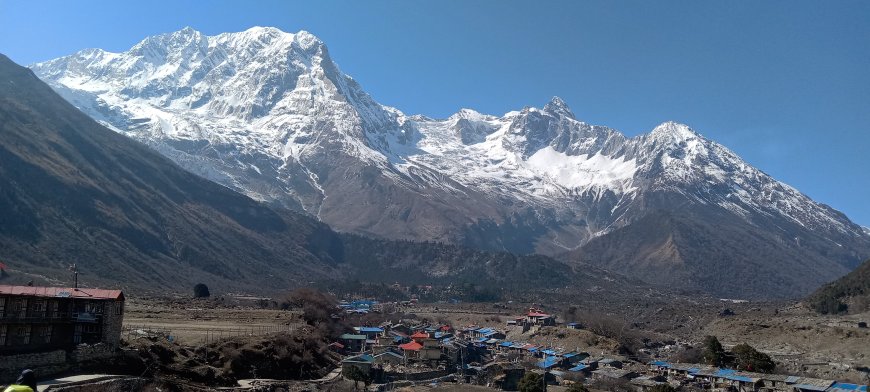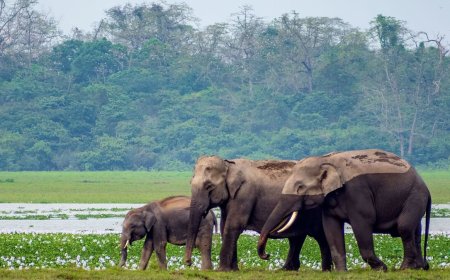How To Pack Lightweight Yet Warm Clothes For the Annapurna Circuit
Learn how to pack lightweight yet warm clothes for the Annapurna Circuit. Discover smart layering tips, gear recommendations, and essential clothing materials to stay comfortable across changing mountain climates.

How To Pack Lightweight Yet Warm Clothes For the Annapurna Circuit
Packing for the Annapurna Circuit trek is all about keeping warm without carrying too much. You'll be going from warm lowlands to chilly mountain areas above 5,000 meters, where it can get cold at night. So, layering up with light clothing is key.
Start with a moisture-wicking base layer made of merino wool or synthetic materials. These fabrics pull sweat away from your skin, which helps prevent chills and blisters. Stay away from cotton since it holds moisture. On top of that, wear a lightweight fleece or thin down jacket. Itll keep you warm but also breathable and easy to pack.
For your outer layer, grab a waterproof and windproof jacket and pants. Look for breathable materials like Gore-Tex to keep you dry without making you too hot. Packable shells are a great choice since they dont take up much space.
Dont forget some warm accessories like a hat, gloves, and a neck gaitertheyre small but help keep you warm. Good thermal socks and a solid pair of insulated trekking boots will also make a difference.
To keep weight down, pick clothes that can do more than one thing, dry quickly, and layer easily. Packing cubes or compression sacks can help you organize and save space.
Remember, layering lets you adjust your warmth depending on the weather and how active you are. By combining lightweight, warm, and weatherproof clothes, youll stay comfortable on the Annapurna Circuit without lugging around too much stuff, making your trek safer and more fun.
Understanding the Weather on the Circuit
The Annapurna Circuit has a mix of climates because it goes from the warm subtropical foothills to the chilly heights over 5,000 meters. Youll feel the warmth and humidity in the lower areas, while up higher, it gets cold and dry, especially at night when temperatures can drop suddenly. Weather can change quickly, too, bringing rain or even snow. Knowing how the weather shifts can help you prepare your clothing layers for it. For instance, moisture-wicking fabrics are a must in the warmer, lower areas to keep sweat away, while higher up, youll need insulated layers to stay warm. A weatherproof jacket will be key to shield against wind and rain. Being ready for both hot and cold will make your trek more comfortable and safer.
Choosing the Right Base Layers
Base layers are really important for keeping moisture in check and staying warm on the Annapurna Circuit. Look for materials like merino wool or synthetic fabrics that do a good job of wicking sweat. These fabrics dry quickly, which helps prevent chills from damp clothes. Stay away from cotton since it holds moisture. Lightweight base layers that fit snugly work well for thermal regulation without getting bulky. Its wise to pack at least two sets so you can switch them out or wash them. Good moisture management will help avoid blisters and skin irritations, making your trek more enjoyable. Your base layer is crucial for layering up in the different climates on the circuit.
Selecting Mid-Layers That Keep You Warm
When picking mid-layers for the Annapurna Circuit, go for warmth without adding too much weight. Fleece jackets are a great choice because theyre light, breathable, and keep warm even if they get damp. Lightweight down or synthetic jackets are also good as they pack down small and provide warmth. Avoid heavy sweaters that can weigh you down and limit your movement. A thin insulating mid-layer over your base layer helps you adjust your warmth based on temperature changes and how much you're moving. Mid-layers should be comfortable and allow you to stay warm during colder spells without taking up too much room in your bag.
Picking Weather-Resistant Outer Layers
A good outer layer is key for staying dry and warm against wind, rain, and snow on the Annapurna Circuit. Look for lightweight, breathable, and waterproof jackets and pants made from stuff like Gore-Tex. These materials keep the rain out while letting sweat escape, so you dont get too hot inside. Features like adjustable hoods and vents are handy for controlling your temperature. Lightweight outer layers that pack easily are great as they save space in your bag. Wearing durable outerwear keeps you dry and protected from sudden weather changes, while still keeping your load light.
Why Layering is Important
Layering is a smart way to manage your temperature and comfort on the Annapurna Circuit. It lets you easily add or shed clothing based on how hard youre working or the weather. Start with a moisture-wicking base layer, then add a warm mid-layer, and finish with a weather-resistant outer layer. This setup helps prevent overheating when you're hiking hard and keeps you warm while resting or in colder conditions. Layering also gives you flexibility, so you can quickly adapt to sun, rain, or snow without needing bulky clothes. It's a great way to stay comfortable across the ups and downs of the circuit's climate.
Materials that Keep You Warm but Not Heavy
Some materials are great for warmth without being heavy, which is essential for trekking the Annapurna Circuit. Merino wool is popular for base layers and socks as it insulates well, wicks moisture, and doesnt hold odors. Synthetic blends like polyester and nylon do a good job of trapping heat while drying quickly and packing down small. Lightweight down is great for warmth-to-weight ratio, but it can lose insulation when wet, while synthetic jackets stay warm even when damp. Fleece is breathable and light, making it ideal for mid-layers. Choosing these kinds of fabrics helps you stay warm and dry without weighing down your backpack.
Footwear and Socks: Finding Comfort and Warmth
Getting the right footwear and socks is crucial for staying warm and comfortable on the Annapurna Circuit. Insulated, waterproof trekking boots are essential for keeping your feet dry and warm on tricky terrain. Make sure your boots are well broken in to prevent blisters. Pair them with moisture-wicking thermal socks; merino wool blends work great for both warmth and sweat control. You might consider wearing thin liner socks under thicker wool ones to avoid blisters and add extra warmth. Its a good idea to bring extra pairs to keep your feet dry. The right footwear and sock combo helps prevent cold feet and blisters, which can put a damper on your trek. Comfort and fit are key since youll be on your feet for long hours.
Accessories that Keep You Warm
Accessories like hats, gloves, and neck gaiters are important for keeping your body heat in and protecting you from the mountain weather on the Annapurna Circuit. A warm hat that covers your ears can keep a lot of heat from escaping, which is super important in cold, windy conditions. Gloves should be waterproof and insulated, and its nice to have liners for added flexibility. Neck gaiters help shield your face and neck from cold air, dust, and sun. These lightweight items are small but make a big difference in your comfort, especially in the early mornings or if the weather turns. Bringing good accessories rounds out your layering and helps you handle the changing weather on the circuit.
Packing Tips for Smart Trekking
When youre packing for the Annapurna Circuit, keeping your bag light but efficient is key. Start with clothes that layer easily and dry quickly. Use packing cubes or compression sacks to organize while minimizing bulk. Only bring what you needskip the duplicates and heavy fabrics. Lightweight gear, like down jackets and thin waterproof shells, is easier to carry. Try to choose versatile accessories that can be used in different ways, such as buffs that can work as scarves or headbands. Distributing the weight evenly in your bag helps you stay balanced and reduces fatigue. Thoughtful packing ensures comfort on the trail and makes for a more enjoyable trek.
Taking Care of Your Clothes on the Trek
Properly caring for your clothes on the Annapurna Circuit helps them last longer and keep performing well. Wash base and mid-layers regularly with biodegradable soap in clean water to get rid of sweat and dirt that can reduce insulation and breathability. Make sure to air-dry everything daily to prevent dampness and odors. Dont over-wash waterproof gear to keep its protective features intact; try spot-cleaning instead. Handle delicate fabrics carefully and store everything dry at night. Rotate your socks each day and dry your boots inside and out. Taking care of your clothing helps you stay comfortable and warm while keeping your gear in good shape throughout your trek.
What kind of sleeping bag for the Annapurna Circuit?
For the Annapurna Circuit, youll want a sleeping bag rated for temperatures between -10C to -15C (14F to 5F). Nights get cold, especially above 3,000 meters. A down sleeping bag is great for keeping you warm without being too heavy or bulky, but if you think it might be damp, a synthetic bag is a decent choice too. Go for a mummy shape with a hood to keep the warmth in. You might also want a sleeping bag liner to add some extra warmth and keep your bag clean. Make sure its lightweight and packs down small since youll be carrying it during the trek.
What weight pack for the Annapurna Circuit?
The ideal weight for your pack on the Annapurna Circuit is between 10 to 15 kilograms (22 to 33 pounds). This should include everything like clothing, your sleeping bag, food, water, and personal items. If you hire a porter, you can get away with carrying around 5 to 7 kilograms, making the trek a lot easier. A lighter pack means less fatigue, better balance on tough trails, and a lower chance of getting hurt. Stick to packing just the essentials and choose lightweight gear.
What backpack is best for Annapurna?
A backpack with a capacity of 40 to 50 liters is perfect for the Annapurna Circuit. It should have a solid frame, adjustable padded shoulder straps, and a hip belt for comfort as you carry your gear. Look for features like multiple compartments, space for a hydration bladder, a rain cover, and compression straps. Its best to get one made of durable, water-resistant material to keep your stuff safe from rain and dust. Comfort is key, especially for long days, so make sure it also allows for easy access to things like snacks and extra layers.
Do you need a guide for the Annapurna Circuit?
You dont have to go with an Annapurna base camp Trek guide on the Annapurna Circuit, but its a good idea, especially for first-time trekkers or if youre not familiar with trekking at high altitudes. Guides can help you find your way, offer advice on how to adjust to the altitude, and give insight into the local culture. They also make sure you get the permits you need and can assist in emergencies. Having a guide can make your trek safer and less stressful while giving you a richer experience. If youre an experienced trekker and feel up to it, going solo is an option, but be aware of local rules and the benefits of having some support.




























